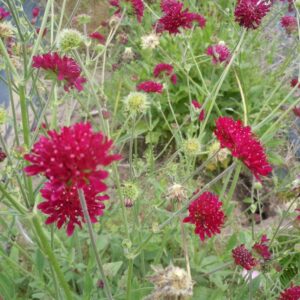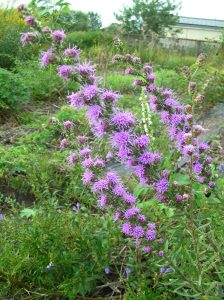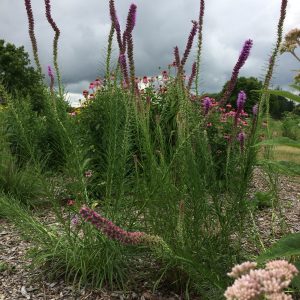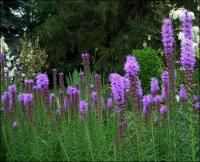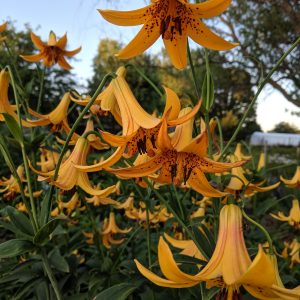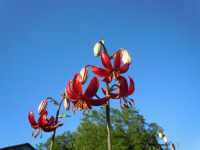Plants for Butterflies and Other Pollinators
Showing 105–112 of 211 results
-
Knautia macedonica syn. Scabiosa rumelica Pincushion plant Z 5-9
Claret pincushions float at the tips of airy wands all summer & fall
Claret pincushions float at the tips of airy wands all summer & fall
Size: 2- 3’ x 10”
Care: sun in well-drained soil. Keep compact by cutting back to 10” in spring, if you wish
Native: Central Europe
Wildlife Value: attracts butterflies and beesKnautia named for German doctor & botanist Christoph Knaut (1656-1716) who published a method of classifying plants. Collected before 1879
-
Kniphofia triangularis Dwarf Red hot poker Z 5-8
From early to late summer, with dead-heading, vivid coral spikes, like a torch .
From early to late summer, with dead-heading, vivid coral spikes, like a torch. This plant has everything- resistant to deer & rabbits, long blooming, great cut flowers, hummingbirds and butterflies love it.
Size: 2’ x 12-18”
Care: sun in moist to well-drained soil, Drought tolerant once established
Native: mountain grassland & moist areas in the Eastern Cape to the Northern province of South Africa.
Wildlife Value: resistant to deer & rabbits, hummingbirds and butterflies love it.1st described in 1854 in Enumeratio Plantarum Omnium Hucusque Cognitarum, Vol. 4 p. 551
-
Liatris aspera Rough blazing star Z 4-9
Feathery purple buttons along tall spikes August-October
OUT OF STOCK
Feathery purple buttons along tall spike in late summer: August-October
Size: 24”-30” x 12”-18”
Care: Sun in well-drained soil
Native: So. Canada, much of eastern 3/4th of U.S., Wisconsin Native
Wildlife Value: attract butterflies (favorite nectar for Monarchs and Buckeyes) & hummingbirds.Aspera is Latin meaning rough. 1st collected by Frenchman André Michaux (1746-1802) who spent 11 years in America collecting hundreds of new plants.
-
Liatris pycnostachya Prairie blazing star Z 3-9
Tall, erect, purplish- pink spike in August-September
OUT OF STOCK
Tall, erect, purplish- pink spike in August-September
Size: 4’ x 1-2’
Care: well-drained soil in full sun
Native: central & SE US
Wildlife Value: deer resistant, attracts birds, butterflies, and beesCollected by French planthunter Andre Michaux in 1795 on the prairies of Illinois. About 9 years later collected on the Lewis & Clark Expedition in South Dakota September 1804
-
Liatris spicata Blazing star, Gayfeather, Button snakeroot Z 3-8
Rosy purple spikes in July and August, a flower arranger’s dream
Rosy purple spikes in July and August, a flower arranger’s dream
Size: 2-3' x 18"
Care: Full sun in moist to well-drained soil.
Native: Eastern and southern U. S., Wisconsin native
Wildlife Value: favorite nectar source for Buckeye butterflies & host for caterpillars of Painted lady, Fritillaries, Skippers, Sulphurs, Coppers & Checkerspot butterflies.Native Americans used roots medicinally for backaches, colic, dropsy and to strengthen a weak heart. The Dakota recognized L. spicata as an indication “when the flower is blue-red that corn is good to eat.” Nicollet Diary, August 13, 1838. The dried root reputedly repelled moths from stored clothes. First collected by English naturalist Mark Catesby (1683-1749) and cultivated since 1732. Grown at America’s 1st botanic garden, Elgin Botanic Garden 1811.
-
Ligularia stenocephala Leopard plant Z 4-8
Daisy-shaped buttercup to golden yellow flowers cover narrow, 4-5 ‘tall spikes from late summer to early fall. Its foliage is as arresting as the flowers. Big, rounded-triangular shaped leaves with sharply scissored edges surround the bottom with smaller ones cover the stems until the leaves meet the bottoms of the flower spike.
Daisy-shaped buttercup to golden yellow flowers cover narrow, 4-5 ‘tall spikes from late summer to early fall. Its foliage is as arresting as the flowers. Big, rounded-triangular shaped leaves with sharply scissored edges surround the bottom with smaller ones cover the stems until the leaves meet the bottoms of the flower spike.
Size: 5’ x 5’
Care: part shade in moist soil
Native: China, Taiwan, and Japan
Wildlife Value: a favorite nectar and pollen source for bees and butterflies. Rabbit resistantCollected and first named by Russian botanist Carl Johann Maximowicz (1827 – 1891). St. Peterburg Botanic Garden sent him to South America where he searched for plants around Rio, then crossing Cape Horn he collected in Hawaii. After his ship was commandeered off the coast of China, he crossed China from west to east through China and Siberia recording his specimens that grew along the Amur River. He returned traveling west to east then crossed the East China Sea of the Pacific Ocean to Japan where he collected for four years.
-
Lilium canadense, Z 2-6
Showy, drooping bell-shaped flowers from lemon to dark orange in color with conspicuous red spots on the inside
OUT OF STOCK
Showy, drooping flowers from lemon to dark orange in color with conspicuous red spots on the inside.
Size: 2-4’ x 6”
Care: part shade in moist to moist well-drained, slightly acidic soil
Native: Upper Great Lakes & southern Canada
Wildlife Value: attracts butterfliesIntroduced to gardens from its native North America by Jacques Cartier, 1535. Also collected by Swedish botanist Pehr Kalm (1716-1779) who collected in Northeastern US and SE Canada and sent it to Linnaeus. Grown at America’s 1st botanic garden, Elgin Botanic Garden 1811. Listed in the 1873 catalog of Leichtlin’schen Gartens in Baden-Baden.
-
Lilium martagon Martagon lily Z 3-8
Usually pink to carmine, smallish downfacing, reflexed petals, with one stem baring up to 50 individual flowers on mature plant.
OUT OF STOCK
Usually pink to carmine, smallish downfacing, reflexed petals, with one stem baring up to 50 individual flowers on mature plant.
Size: 3-6’ x 8-12”
Care: part shade to sun (shorter in sun) in well-drained, lime soil. Resents being moved & often will not emerge in 1st year.
Native: Eastern France to Korea.
Awards: Royal Horticultural Society Award of Merit; Elisabeth C. Miller Botanic Garden Great Plant Pick.The name Martagon means cap in Turkish from the style of turban adopted by Turkish ruler, Sultan Mohammed, which was known as a martagon and had a similarly pendulous shape. Described by English herbalist Gerard (1545-1612) in 1596.

